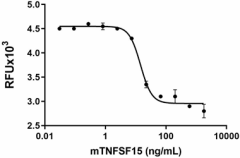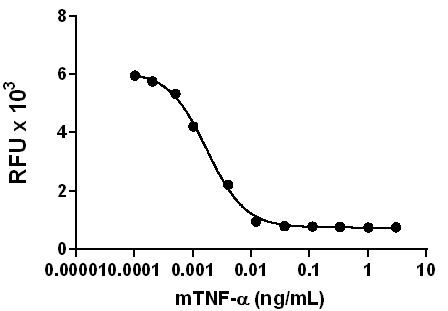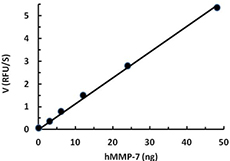- Regulatory Status
- RUO
- Other Names
- TNF ligand-related molecule 1 (TL1), TL1A, vascular endothelial cell growth inhibitor (VEGI)
- Ave. Rating
- Submit a Review
- Product Citations
- publications

-

Recombinant mouse TNFSF15 induces apoptotic death in human erythroleukemia TF-1 cells. The effect was measured with Deep Blue Cell Viability™ Kit (Cat. No. 424701). ED50
| Cat # | Size | Price | Quantity Check Availability | Save | ||
|---|---|---|---|---|---|---|
| 753006 | 100 µg | 559€ | ||||
TNFSF15 is member 15 of the tumor necrosis factor (ligand) superfamily and also is a type II transmembrane protein. It is expressed as a membrane-bound protein and later released as a soluble protein via the ectodomain shedding by TNF-α converting enzyme (TACE). TNFSF15 exhibits approximately 20-30% homology to other TNFSF members. The functional receptor of TNFSF15 is the death receptor 3 (DR3). The engagement of this receptor on T cells by TNFSF15 expressed on dendritic cells (DCs) triggers a costimulatory signal in the T cells that induces IFN-γ production via NF-κB. DR3+ tumor cell lines treated with soluble TNFSF15 in the presence of cycloheximide results in caspase-dependent apoptosis. The TNFSF15-DR3 interaction is inhibited by the DcR3 decoy receptor. DcR3 also binds to LIGHT (TNFSF14) and FasL (TNFSF6). TNFSF15 in conjunction with IL-12, IL-15, and IL-18 induces the expression of co-stimulatory molecules CD40L (CD154) and OX40 (CD134) on activated CD4 T cells. The co-stimulatory process is associated with the expression of IL-2Rα (CD25) and α-chain of LFA-1 (CD11a) on CD4 T cells. Also, the costimulation with TNFSF15 induces IL-22 and GM-CSF. In addition, TNFSF15, in concert with IL-12, IL-15, and IL-18, induces the production of IL-6 and TNF-α from leukocytes of healthy donors. TNFSF15 has been associated with inflammatory bowel disease (IBD), and its expression correlates with the severity of intestinal inflammation and increased IFN-γ production in intestinal lamina propria. In addition, TNFSF15 (produced by lamina propria macrophages) induces Th1 and Th17 immune responses in cooperation with IL-23 in patients with Crohn's disease. TNFSF15 is also related to rheumatoid arthritis (RA), ankylosing spondylitis, and psoriasis.
Product DetailsProduct Details
- Source
- Mouse TNFSF15, amino acids Met-(Ile76-Leu252) (Accession# NM_177371), was expressed in E.coli.
- Molecular Mass
- The 178 amino acid recombinant protein has a predicted molecular mass of approximately 20 kD. The protein migrates at approximately 20 kD in both DTT-reducing and non-reducing conditions by SDS-PAGE. The predicted N-terminal amino acid is Met.
- Purity
- >95%, as determined by Coomassie stained SDS-PAGE.
- Formulation
- 0.22 µm filtered protein solution is in PBS, pH 7.2.
- Endotoxin Level
- Less than 0.01 ng per µg cytokine as determined by the LAL method.
- Concentration
- 10 and 25 µg sizes are bottled at 200 µg/mL. 100 µg size and larger sizes are lot-specific and bottled at the concentration indicated on the vial. To obtain lot-specific concentration and expiration, please enter the lot number in our Certificate of Analysis online tool.
- Storage & Handling
- Unopened vial can be stored between 2°C and 8°C for up to 2 weeks, at -20°C for up to six months, or at -70°C or colder until the expiration date. For maximum results, quick spin vial prior to opening. The protein can be aliquoted and stored at -20°C or colder. Stock solutions can also be prepared at 50 - 100 µg/mL in appropriate sterile buffer, carrier protein such as 0.2 - 1% BSA or HSA can be added when preparing the stock solution. Aliquots can be stored between 2°C and 8°C for up to one week and stored at -20°C or colder for up to 3 months. Avoid repeated freeze/thaw cycles.
- Activity
- Recombinant mouse TNFSF15 induces apoptotic death in human erythroleukemia TF-1 cells. The effect was measured with Deep Blue Cell Viability™ Kit (Cat. No. 424701). The ED50 for this effect is 7 - 35 ng/mL.
- Application
-
Bioassay
- Application Notes
-
BioLegend carrier-free recombinant proteins provided in liquid format are shipped on blue-ice. Our comparison testing data indicates that when handled and stored as recommended, the liquid format has equal or better stability and shelf-life compared to commercially available lyophilized proteins after reconstitution. Our liquid proteins are verified in-house to maintain activity after shipping on blue ice and are backed by our 100% satisfaction guarantee. If you have any concerns, contact us at tech@biolegend.com.
- Product Citations
-
Antigen Details
- Structure
- Homotrimer.
- Distribution
-
Endothelial cells, endothelial progenitor cells, monocytes, monocyte-derived dendritic cells (DCs), synovial fibroblast-like cells, and CD4 and CD8 lymphocytes.
- Function
- TNFSF15 acts as a costimulatory signal inducing T cell proliferation and secretion of IFN-γ and GM-CSF. Its expression is induced by TNF-α, IL-1-α, and PMA.
- Interaction
- Activated T cells, natural killer (NK) cells, NKT cells, macrophages, and endothelial cells.
- Ligand/Receptor
- DR3 (TNFRSF25) and decoy receptor TR6/DcR3 (TNFRSF6B).
- Biology Area
- Immunology, Innate Immunity
- Molecular Family
- Cytokines/Chemokines
- Antigen References
-
1. Migone TS, et al. 2002. Immunity 16:479.
2. Bamias G, et al. 2003. J. Immunol. 171:4868.
3. Kamada N, et al. 2010. Inflamm. Bowel Dis. 16:568.
4. Aiba Y, Nakamura M. 2013. Mediators Inflamm. 2013:258164.
5. Reichwald K, et al. 2014. PLoS One 9(8):e105627.
6. Reichwald K, et al. 2014. PLoS One 9(1):e85793. - Gene ID
- 326623 View all products for this Gene ID
- UniProt
- View information about TNFSF15 on UniProt.org
Related Pages & Pathways
Pages
Related FAQs
- Why choose BioLegend recombinant proteins?
-
• Each lot of product is quality-tested for bioactivity as indicated on the data sheet.
• Greater than 95% Purity or higher, tested on every lot of product.
• 100% Satisfaction Guarantee for quality performance, stability, and consistency.
• Ready-to-use liquid format saves time and reduces challenges associated with reconstitution.
• Bulk and customization available. Contact us.
• Learn more about our Recombinant Proteins. - How does the activity of your recombinant proteins compare to competitors?
-
We quality control each and every lot of recombinant protein. Not only do we check its bioactivity, but we also compare it against other commercially available recombinant proteins. We make sure each recombinant protein’s activity is at least as good as or better than the competition’s. In order to provide you with the best possible product, we ensure that our testing process is rigorous and thorough. If you’re curious and eager to make the switch to BioLegend recombinants, contact your sales representative today!
- What is the specific activity or ED50 of my recombinant protein?
-
The specific activity range of the protein is indicated on the product datasheets. Because the exact activity values on a per unit basis can largely fluctuate depending on a number of factors, including the nature of the assay, cell density, age of cells/passage number, culture media used, and end user technique, the specific activity is best defined as a range and we guarantee the specific activity of all our lots will be within the range indicated on the datasheet. Please note this only applies to recombinants labeled for use in bioassays. ELISA standard recombinant proteins are not recommended for bioassay usage as they are not tested for these applications.
- Have your recombinants been tested for stability?
-
Our testing shows that the recombinant proteins are able to withstand room temperature for a week without losing activity. In addition the recombinant proteins were also found to withstand four cycles of freeze and thaw without losing activity.
- Does specific activity of a recombinant protein vary between lots?
-
Specific activity will vary for each lot and for the type of experiment that is done to validate it, but all passed lots will have activity within the established ED50 range for the product and we guarantee that our products will have lot-to-lot consistency. Please conduct an experiment-specific validation to find the optimal ED50 for your system.
- How do you convert activity as an ED50 in ng/ml to a specific activity in Units/mg?
-
Use formula Specific activity (Units/mg) = 10^6/ ED50 (ng/mL)
 Login / Register
Login / Register 












Follow Us